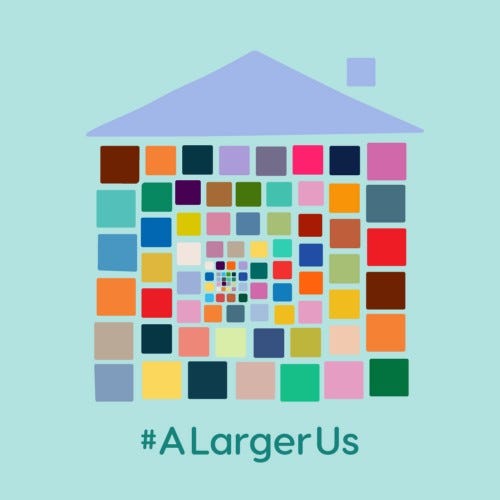Collective storytelling: Anger mobilizes, hope organizes
News about the future of hope-based communication
What is Collective Storytelling?
Collective storytelling is a communication strategy based on global organizing. It means carrying out stories together, and spreading them together.
Anyone can tell a good story. But for the story to strategically change attitudes and behavior, we have to do it together.
Collective storytelling means we are all involved in the story: first we carry it out together. And secondly, we tell it together and we share it together.
1. Bringing stories to life through action
If we want to get a message across, we need to organize influencers to act out the story themselves. We all have to be protagonists in the story now, not just viewers. It is not enough to ask a million people to sign a petition, we have to design an action people can carry out that visually demonstrates support and belonging to a cause.
To show support for migration and welcoming societies, we need people to engage in acts of welcome, for example dinners where hosts and newcomers come together.
To show support for environmentalism, we need people connecting to nature, for example bird-watching or even hugging trees.
Now more than ever, your audience needs to be able to bring your cause to life through their own action. What this looks like is something we try to figure out in hope-based workshops by asking questions like “What does it look like to “do” human rights?”
What matters here is that it is not enough to protest about something: you have to bring your vision and values to life. Julia Roig recently shared a study showing that when audiences see a protest, the narrative they take away is usually more about the fact that a protest is happening, rather than the issue or change protesters want to draw attention to.
From Words to pictures: What does it look like to act on your value?
Narrative power today and in future depends on turning your idea into pictures. Political ideas will only spread if they can be acted upon by everyday people in front of smartphone cameras.
The power of the image over word has been multiplied exponentially, meaning narratives are shaped for more by what we do rather than what we say. If your message is not visual, it will not spread.In today’s digital ecosystem, values and messages will only spread if they can be translated into simple visual actions that influencers can bring to life themselves, in front of their own camera.

2. Strategically working together to elevate stories
The second imperative for collective storytelling is that content (aka stories) will not be seen unless other people engage with and share it. That very rarely really happens organically. We have to organize our communities to strategically elevate and amplify the stories that we believe are important drivers of thinking and action - the change we want to see.
Breaking news: big media outlets no longer set the agenda alone. No organization can spread a narrative alone, not even if they have access to big media outlets. We all need to work together to strategically create and share stories that bring to life the change we want to see in the world.
This is about getting your movement organized to elevate and amplify the stories that bring your values and vision to life: that show people acting the way you want more people to act in future. In an era of mass decentralized storytelling, narrative power depends on your ability to organize large numbers of people to tell and share a collective story.
Practically, it means building Whats App communities to spread stories and shape conversations. It means organizing love armies to spread the stories that spread love and shared humanity. As Narrative Initiative remind us, stories are to narratives what tiles are to mosaics.
What matters here is being strategic about the stories we elevate and amplify, because human beings are social animals who learn behavior from the things they see other humans do, and learn to accept ideas as common sense or reject them as taboo based on what they see other people in their group accept or reject. In other words, seeing people in your community being pro-migration gives social permission to share that viewpoint too.
Do we tell the story of a community rejecting newcomers, or the community that welcomes them? This is a strategic choice.
Collective storytelling needs to be driven by a shared and deep narrative change goal. For us, that goal is promoting shared humanity: which we can promote by elevating and amplifying stories that show what a world with more humanity looks like. Too often, the stories that make us believe in human progress are overshadowed by stories that reduce our trust in our fellow human beings, thus reducing our likelihood to work together.
If we can articulate the basic values that we have in common, we can work together to reinforce those ideas and ways of thinking stronger in society.
Collective storytelling requires a shift from mobilizing to organizing
Hahrie Han talks about the difference between mobilizing people and organizing them.
When we mobilize, we are telling people what to do. Sign this petition, share this news, go and protest about this crisis.
When we organize, we are empowering other people to find ways to act on our shared values, to find new pathways to our shared goals. This involves relinquishing control and trusting others to bring honor to our cause with their words and actions.
A key principle for the Center for Hope-based Communication is that while fear mobilizes, hope organizes.
Fear mobilizes: it is a powerful tool if you want to get your audience to perform one-off transactional actions. To build a movement where people regularly think up their owns ways to act upon shared goals and values, we need something more sustainable: hope organizes.
Every movement faces an imperative to offer people an opportunity to act on the values they espouse. If you ask them to sign petitions and go to protests, you are mobilizing them. If you give them a way to live your cause, you are organizing them.
So the question that kind of arises here for anyone looking to practice hope-based communication, particularly for changemakers, is, what does it look like for people to be part of our movement? What does it look like when they act on our values?
Our plan: A hope army for shared humanity
We are building a Center for Hope-based Communication because we want to organize people to focus our activism and sotrytelling on the change we want to see. Because we want to organize hope.
This is communication strategy designed for a world where we have to get ideas across visually and through real people doing real things in front of their smartphone camera. In a world where we are all influencers, we have to tell stories collectively in order to be influential.
This means organizing people to create and share stories that bring narratives to life, but also to work together to elevate and amplify those stories when they happen. A little like the Swedish “love army” that mobilizes to respond to trolling, but this time proactively supporting new voices with new visions proactively. [I am trying to find a non-military synonym for “army” here that captures the collective action we want the community to carry out. Any ideas?]
Rituals and habits of hope
Part of this work will involve designing new forms of activism that people can carry out to visually act on common interest values.
We need to design new habits and rituals that people can carry out to create a sense of community and belonging around the concepts that matter to our future: democracy, human rights, equality, living in harmony with nature etc. People need to see something (regularly) to believe it, and today we only tend to see things that other people are doing (as opposed to simply talking about).
There is a lot more to say on ritual and habits of hope, so I will do a follow-up post in the autumn.
Why all this matters (the fear-based stuff)
Social change activism and communications must adapt to the TikTok era because the far-right are already there, creating connection to tens of millions of apolitical followers with apolitical content. Just a few examples are WhatsApp groups spreading hate in India, Presidents organizing influencer armies in El Salvador, media moguls training influencer armies in France.
I am not surprised to see young people voting for the far-right, because the far-right is making an effort to reach them on the platforms they use. There is massive state investment in fear and hate online: no wonder fear and hate seem to dominate our lives and politics.
Imagine we invested just a fraction of those resources in strategically spreading shared humanity?
Hopey, changey stuff
If you have ever taken part in a hope-based workshop, you can also help us build this new organization by taking this detailed 15-minute survey which he have designed to identify the impact it has on people.
The PILS Project blog highlights the tools we have to achieve climate justice and the need for a deeper mindset shift to use them effectively. Thanks to Emma Cassidy for the tip.
We have finished phase one of the Rewire Your Mind incubator. It gave me so much joy to see changemakers from Poland, Bulgaria and Hungary carrying out hope-based workshops and sharing their certificates. We have a very exciting phase two coming after the summer break, with a focus on adapting resilience and mindset tools from psychology to make civil society more innovative and effective (including a cool thing called the Activist Hope Scale!). Big thanks to project partners Unhack Democracy and Mindbridge.
Speaking of Mindbridge, a reminder to check out their neuroscience for HRDs course.
Quote of the week
Thanks to Christopher Keefe for sharing this interview with Robert Ludlum,illustrating the shared humanity worldview that we want to promote:
To what extent do we think that we’re all in this together, or it’s every man for himself, or every man or woman? And that has exactly the same trend. What caused that? I am trying to get to the issues of causation because it turns out to be morality, according to my reading of this evidence. What stands upstream of all these other trends is morality, a sense that we’re all in this together and that we have obligations to other people.
(the interview also higlights the role of loneliness in fascism, something also identified by Hannah Arendt)
Thanks for reading. One of the principles we will build into our new organization is well-being. Which means we will pause our operations every August to give everyone a full and deep digital detox. Next week we will send our one last substack with some summer reading recommendations!
Meanwhile, here is a last request to join the waiting list for the new Center for Hope-based Communication!







Great to see this Thomas! Congratulations 🥳